Vintage Safety Posters Save The British from Demise
Well, maybe not like the Invasion of Normandy but vintage safety posters were taken very seriously in the UK from 1930 into the 1970s. These were supported by British charity organization RoSPA (The Royal Society for the Prevention Of Accidents). The posters are on public display now from the RoSPA and prints are available to the public. This showing was actually made possible from a discovery of nearly 700 posters from cleaning out an old warehouse. (see video below)
Birth of The RoSPA
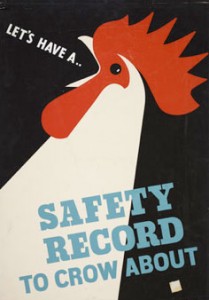 The organization started some 97 years ago with its first safety campaign, getting pedestrians to walk facing traffic. The program was an overwhelming success saving a huge percentage of pedestrian lives. So, successful that between 1924 and 1942 there were millions of safety codes written including “The Highway Code”, “Analysis of Causes of Accidents” and the “Kerb Drill” (this was a kerb drill designed for children)
The organization started some 97 years ago with its first safety campaign, getting pedestrians to walk facing traffic. The program was an overwhelming success saving a huge percentage of pedestrian lives. So, successful that between 1924 and 1942 there were millions of safety codes written including “The Highway Code”, “Analysis of Causes of Accidents” and the “Kerb Drill” (this was a kerb drill designed for children)
Keep The English Safe!
The vintage safety posters did not come along until the 1930s. The campaigns continued on with 1945s “Safety Standards for Fireguards” (fire safety), “The Cycling Proficiency Scheme” (for bicyclists) in 1947 and “The Tufty Club” 1961 (geared towards children with a cartoon squirrel family giving safety tips).
Every year or couple of years it seems a new safety campaign would be created for the times. In the 1950s there was Industrial and factory safety, 1960s the drink-drive campaign, 1980s wheel chair proficiency program (for the disabled). Many, many successful safety campaigns were created and the RoSPA is still alive and running today!
The U.S.A. and Posters for The People
Great minds think alike. That would be The UK and The USA. I wrote an article earlier this year America Shows Guts With Vintage Community Posters on the WPA (Works Projects Administration). It was started in 1935 as part of the Roosevelt “New Deal” program. This American program promoted vintage safety posters but also community driven messages to enhance peoples lives and promote hope and prosperity. The program was designed to put people back to work and get positive slogans and messages out. The WPA posters were more of the “woodblock” printing and art deco style. It was a huge advancement in American poster design and printing at the time. But, when examined today, they are aesthetically pleasing collectable little works of art.
We Love Vintage Posters
Our Magical History Tour @ Famous Rock Posters is growing in scope. We began our journey concerning ourselves with the aesthetics, collectibility, and investment quality of vintage rock posters from the 60’s. But, when you research the origins of art and posters it leads you to some incredibly interesting connections and stories. Pieces of the puzzle that would eventually bloom into little masterpieces we called the “psychedelic rock posters”.
The history of vintage posters and counter culture evolvement is amazing. Vintage safety posters, propaganda posters, public service posters and even travel posters (1930’s-40’s) were influential and hugely successful campaigns around the world. An effective art form getting a message to the people (for better or worse).
Links:
How Soviet Propaganda Posters Rivaled U.S.A.’s Posters For The People
In May 2013 I did a piece on American vintage community posters from 1935-1943. Little did I know (until today) that there was a Soviet Propaganda Posters program running almost parallel to the one we had. (Why am I not surprised?) Just think about it. The Soviet Union (now Russia) was our biggest competitor and threat at the same time. (The Cold War, Space Race, nuclear ARMS race, etc.) 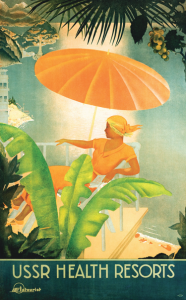 The posters will be displayed @ The GRAD (Gallery for Russian Arts and Design) in London this summer.
The posters will be displayed @ The GRAD (Gallery for Russian Arts and Design) in London this summer.
Actually, if you look at the focus of each program they are different. The Soviet propaganda posters were specifically targeted to Western culture. Enticing visitors to come see the glamourous, beautiful, picturesque country of The USSR. Posters exuding “we are not the enemy, but a friendly, leisurely, gorgeous and modern place for a trip” with slick language, graphics and colors. The designs of the posters were of an avant garde or art deco type of style. That style was very recognizable and popular in America and Europe at the time.
American Posters For The People
Around 1935 the good ole’ U.S. of A. created The WPA (Works Projects Administration) to put people back to work. The affiliated FPA (Federal Art Project) put artists back to work. It started the Posters Division to enlighten, give hope and inform people of community activities. They were created to make public announcements (e.g. bridge openings, health concerns, cultural events) and give insight into the general welfare of Americans. These posters have an art deco look. However, they are even more stylized through the introduction of woodblock, silkscreening and lithography processing. A defining style and continuity runs through this series of posters that speaks “USA”.
Intourist – USSR Poster Program
Of course with a division named “Intourist” you can imagine the posters were focused on travel. These Soviet propaganda posters are superbly crafted, rare and highly collectable. But, the most glaring thing is, they represent a country that was never there! They were over the top. Some instances suggesting travel to the Soviet Union as exotic as a trip to The French Rivera. As a matter of fact, after examining the posters, you would be hard pressed to distinguish one place from the other. A sophisticated, luxurious destination never to be found.
Most of the USSR art deco travel posters were pre -World War II and the program started in 1929. So, it had a very short (if not highly productive) existence. But, after this alluring eloquent campaign to lure travelers from around the world, The Soviets shut it down. During the late 30’s the Soviet propaganda posters program was replaced by a a more “party” driven military / textile poster program promoting the union. Critics have noted these were propaganda driven, as well.
Links:
Posters For The People Freebies
America Shows Guts With Vintage Community Posters
How Was The Muse Prog Rock Show In Atlanta?
Well, a couple of questions may come to mind before we get started. What is prog rock and who are Muse? Are (British Rockers) M– USE prog rock (progressive rock)? (or) do they come under the category of an “arena rock” or “anthem rock” band? These details seem to be hot topics of debate on blog sites like Prog Archives.com
These sites are dedicated to progressive rock (more on this later) and tout subtitles like “Your Ultimate Prog Rock Resource”. Speaking of which, Famous Rock Posters.com (this site) is dedicated to artists of all kinds. Music, poster art, commercial art, fine art, graphic art, and literature are all represented here, just to clarify any question of relevance.
The Arena
Anyway, back to the M– USE prog rock show we attended Wednesday night September 4, 2013.  It took place @ The Arena at Gwinnett Center-Duluth, Ga. (Metro Atlanta). My wife and I have attended four concerts there , so far. This arena opened in 2003, so it is relatively new (as far as venues go). It actually does feel very new and well maintained. It was well staffed, plenty of options for adult refreshments and clean rest rooms.
It took place @ The Arena at Gwinnett Center-Duluth, Ga. (Metro Atlanta). My wife and I have attended four concerts there , so far. This arena opened in 2003, so it is relatively new (as far as venues go). It actually does feel very new and well maintained. It was well staffed, plenty of options for adult refreshments and clean rest rooms.
Lets get to the acoustics of the venue. We got floor tickets (again) because the sound was so good from the last concert we attended there. This Muse concert was no exception. Bass would be thumping your chest but, you were still able to speak and hear over pretty loud volumes. That goes to a great mix and sound crew.
Muse “Live”
I was going to start this article with that quote from Mr. T..”I pity the fool that missed this concert” but, I guess it works just as well here. Yes, it was one of those. It was phenomenal. I said (more than a few times) it felt like I was being transcended into another cosmos. Literally a bombastic, beautiful, wonderful, and colorful assault on all of the senses. Goosebumps, much of the time.
Now I may be a little bias here ( because I am a fan) but, this was such an experience I could only equate it to the 1960s Fillmore and Avalon Ballroom concerts we have discussed here many times. The concentration on sound and lights was intense. There was a huge folding cube of LED screens ascending from the ceiling (see attached picture) being fed all kinds of data and live feed.. Also, there was a laser light show like I’ve never witnessed in my life.
All of that along with the perfection, power and force of Muse’s musical performance was just about too much. Had us dancing, on our toes, and applauding for more. They also graced us with an encore, which was great as well. Sound like a rock show? It will go in the books as was one of the best!
Are Muse Prog Rock?
After reading and hearing different view points today, I would have to say its ultimately up to the listener. Progressive rock (prog rock) is usually a fusion between rock and jazz or classical music. (e.g. Emerson Lake & Palmer, Yes, Rush, King Crimson). I personally hear a definite “progressive rock” element in M– USE compositions. Most in this debate would agree with that, I believe. My wife likes the “anthem rock” aspect of Muse very much (e.g. “Uprising”). Anthem songs bring strong clear message usually sung in solidarity. Other examples of anthem rock bands includes (the biggie) Queen (e.g. We Will Rock You), David Bowie, T. Rex, and Mott The Hoople, etc.
So, depending on your taste you may not call this a Muse Prog Rock show, it could be titled “Muse’s Arena Rock Show in Atlanta” or “Arena Rock Band Muse Plays Atlanta” or something totally different. It’s just what it is to me.
Links:
Bill Ham – Inventor Psychedelic Light Shows
September 4th, 2013 – Set List
Will Society End Up like Aldous Huxley’s Science Fiction Novel?
I was resistant to the western canon of literature as a youth. Much of it was required reading in school. But, because I was a rebel or had a general non-interest in reading, it escaped me. What a difference few decades make! A voraciuos reader now, I find books like Aldous Huxley’s science fiction novel Brave New World, fascinating!
This futuristic (cautionary) tale of a dystopian (or) utopian society, depending on your perspective, is prophetic in many ways. There can be an argument made for both sides. The book describes a world free of war, disease, violence, grief, mental disease, alcohol and drug addiction. 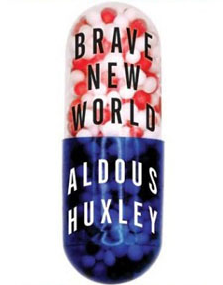 The trade-off is a genetically produced society without monogamous love, family, spiritualism or individual freedoms. Ambition and creativity are frowned upon and extinguished. No personal identity (really) as you are born into a pre-destined class system to do your life’s work. Sometimes you cant help but think, this smacks of Marxism!
The trade-off is a genetically produced society without monogamous love, family, spiritualism or individual freedoms. Ambition and creativity are frowned upon and extinguished. No personal identity (really) as you are born into a pre-destined class system to do your life’s work. Sometimes you cant help but think, this smacks of Marxism!
Discovering Huxley
I sort of backed into reading Brave New World through my research and development on origins and history of the counterculture movement. Huxley has been called the “spiritual father” of the hippie movement. Aldous Huxley’s science fiction novel was published in 1932, but he wrote another one in 1954 which became essential reading for the 60’s counterculture movement.
It is titled “The Doors of Perception”. (Can you guess which rock band got their name from that?) It chronicled Huxley’s 1953 experience on the “psychedelic” natural substance mescaline. He would continue ingesting psychedelics (including LSD) all the way up to his death November 22, 1963 (same day and 3 hrs after The John F. Kennedy assassination).
A Prophetic Novel
Purchasing the novel today, you will receive both “Brave New World” (1932) and “Brave New World Revisited”(1958). The latter touching on his views, reflections and prophecies of the original novel. Many times he makes heavily biased critiques & comparisons to “1984” by George Orwell (one of his colleagues). World overpopulation, drugs, advertising, politics, dictators, brainwashing and other very controversial topics are discussed and how they will affect the future of mankind. Words of warning from his view in 1958.
Brave New World encourages us to keep a close check on our individual freedoms, autonomy and free will. Make sure we are in control of them. Although this tale is melodramatic and an almost unbelievable fantasy, it unveils the bleak side of World Control (and/or) dictatorship versus democracy and freedoms we take for granted daily. Would it be enough to spark the idealists, poets and artists of the early 60’s to drop out and try a sustainable society of their own? Yes, I think Aldous Huxley’s science fiction and other potent literature, music and art of the period had a great influence on what became the counterculture.
Will Society End Up Like a Brave New World?
Many people you query will say, it’s already here! I’ve heard it. Well, I think thats a nice sentiment (if not an exaggeration) on their part. Even though (since Brave New World) we have discovered cloning and test tube babies, it is doubtful things will ever reach the scale and magnitude of the fictional World State’s Hatchery and Conditioning Centre. A baby factory where new borns are brought up with no family ties or values and conditioned by state behaviorist technicians. After thorough brainwashing as youths, they’re integrated into predestined jobs and class system. It’s not in harmony with what I call “The Way of the World” or Natures Way.
It is a very humbling experience being human. Part of that is because we make mistakes and (hopefully) learn from them. How is one to learn and experience life if everything were perfect? And is that life worth living? It paints a bland, gray and uneventful existence to me. Aldous Huxley’s science fiction novel comes off dystopian, evil and corrupt but the society of a Brave New World will never know. They weren’t condtioned that way, so it’s utopia to them.
Important Links You May Enjoy:
Brave New World: A Masterful Critique of Hippy Dreams and Scientistic Hubris
Tons of Beatles Rock Memorabilia Found in Jersey
Not to be mistaken for “Jersey Shores” U.S.A., our story comes from across the pond. In August of 1963, world supergroup The Beatles toured The Channel Islands. This leg of the tour incorporated different ballrooms and auditoriums throughout crown dependancies of Jersey and Guernsey in The English Channel. 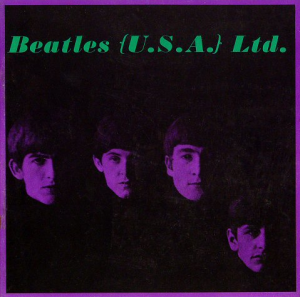 Posters and all types of Beatles rock memorabilia are being made available to commemorate their debut concert tour from 1963. August 6, 2013 (Next Tuesday) begins a 50th Anniversary celebration of The Beatles coming to The Channel Islands. The original tour of the Islands lasted August 6th-10th 1963.
Posters and all types of Beatles rock memorabilia are being made available to commemorate their debut concert tour from 1963. August 6, 2013 (Next Tuesday) begins a 50th Anniversary celebration of The Beatles coming to The Channel Islands. The original tour of the Islands lasted August 6th-10th 1963.
Tracks, LTD.
Tracks, LTD. is one of the world’s largest dealer in Beatles rock memorabilia. During the celebration, they are encouraging the public to submit any Beatles artifacts for free appraisal. This (of course) includes rock posters, concert programs, handbills and ticket stubs etc. It works the same way as the TV show “American Pickers”. People have junk in their attic’s or basements they haven’t cleaned out in decades. Only to find artifacts of rock or Beatlemania ephemera that are rare, collectible and sometimes very, very valuable. Tracks, LTD. says for some reason The Beatles rock memorabilia have doubled in value within the last five years. This major increase is much quicker and higher than most other rock ‘n roll collectibles.
Here are a few examples of how much your posters and stuff may be worth:
- A Channel Islands Beatle concert poster may go for as much as $12,000
- Signed record albums could go from $9,000 -$12,000
- Signed record album of “Sgt. Pepper’s Lonely Hearts Club Band” is one of the most coveted. it will go at auction for around $37,500
- Also, the value of printed pieces, programs and photos of The Beatles has increased tremendously. They are now more collectable & popular than any other rock stars memorabilia.
Beatle Investing
The general public and collectors are watching rock memorabilia allot more closely and more seriously as investments these days. It is becoming, not just a nostalgic whimsical kind a thing, but something worth investing in. Especially with the sharp increase in value on Beatles rock memorabilia. You actually have a “better than fair chance” of turning pieces around for a profit in a relatively short period of time. Remember, their value has doubled or tripled in the past 2 to 5 years. That’s smart money.
Along with Beatle posters and signed Beatle record albums, written material, autographs, fab four clothing, personal items and original posters from The Channel Islands tour are in very high demand. These items will fetch some high bids when auctioned. Also, artifacts of other rock stars are on the rise. Jimi Hendrix, The Rolling Stones, Pink Floyd, Led Zeppelin, The Who and Bob Marley. Rock memorabilia from these artists are highly valued, but not as much as items from the fab four.
Links of interest:
Why Cool Rock Posters From The 60’s are Most Valuable
Posters have always been in trend, whether it is the movie posters or the amazing rock posters. But during the early 60’s there was a huge trend of rock posters of different bands and rock artists. People used to go crazy with the attractive and cool rock posters that were available in the market at cheap prices. Designing such posters was quite tough, as it required the state of art, technique and the style to come up with an interesting idea. You could find these posters on all popular spots like bus stops, telephone poles, bulletin boards and other important places.
Again, the cool rock posters are in high demand and it is owing to their value and importance. Here are a few reasons why rock posters are so valuable.
Historical Importance
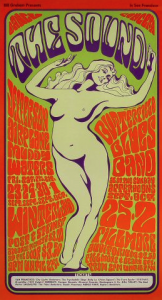
According to the historians, cool rock posters have a great value, as they were the significance during the social movement of the 20th century. As compared to the other collectibles, such form of art helped in shaping the nation. That is why these rock posters are considered to be so important and valued for the interesting ideas behind them.
The increasing popularity of rock posters
There is a huge demand of rock posters all over the work. Fans of music are looking for these rare collections and that this why they have recently become very popular among the people. Not only the fans but also even art lovers want to include them in their collection. The collectors from America are also looking for this rare stuff, which have a lot of historical value. It is because of the simple reason that no other collectible is able to represent the era of the 1960’s, just like the cool rock posters.
Displayed in museums
Designing posters is an art, which is quite difficult to expertise. Many major museums like The San Francisco Museum of Modern Art, The Laguna Art Museum, the Whitney Museum of American Art etc. have organized a number of exhibitions and focusing more on the rock posters. The main motive of these exhibitions was to let the people know about this Psychedelic Art and create awareness about it. Thus, it is a good medium to explore rare and beautiful things at one platform.
Incredible beauty
Cool rock posters are defined by bold colors and a unique message, which every poster depicts. It is a great way to convey your message about the event that will be organized. Even the most popular event promoters like Late Bill Graham are of the view that music is an art and therefore these posters are a fine promotional tool.
Small collection of posters
In the 1960’s, cool rock posters were used for promoting different kinds of events. These posters were pasted on poles, walls and bus stops and as soon as the event was over, it was replaced with a new poster. The only people who were fond of these posters were teenagers who were attracted towards these amazingly designed cool rock posters. At that time, less attention was given to preserving the collectibles and therefore only a few rare collections is available now.
Interesting places to go:
Original Psychedelic Rock Poster Artists Painting Their Environment
Continuing on with my previous post on original psychedelic rock poster artists, we might ponder where the inspiration for such inventive, bold, brilliant works of art would come from. Many might say from the hallucinogens that were ingested at the time. And that would be the easy answer. But, if you examine the lives of these original psychedelic rock poster artists you will find deep-seated roots in art dating back to their childhood.
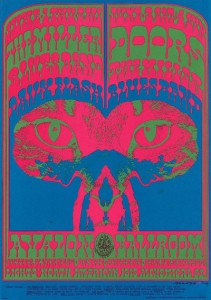
It’s not to say that the popular drugs of the day didn’t have influence in their work (the artists will tell you they did). However, drugs did not make them the brilliant artists they were (or are). You can uncover (actually in many pages of this blog) that the artists came from many backgrounds. Some cartoonists, some musicians, some with minimal accreditation and some with high honors in art instruction. With the innate talent they were born with, these original psychedelic rock poster artists were destined to be artists in one form or another.
In the 1960s it was an open playing field. The new generation wanted to rewrite almost every thing that had been the status quo. This meant not only to be an activist in art, music, literature, film and fashion–but important social and political issues of the day, as well. The germination of these new ideals would come to young minds through literature and discovering the world at large.
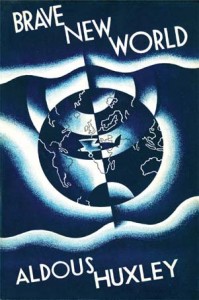 Personally, I believe books like Brave New World by Aldous Huxley were very potent. Bringing an ominous concept of a capitalist world in which people are genetically designed to be passive and useful to the ruling class. Concepts such as family, freedom, love, and culture are considered grotesque. Enough to start a fire? Considering the state of affairs of our country in the 1960s, maybe so.
Personally, I believe books like Brave New World by Aldous Huxley were very potent. Bringing an ominous concept of a capitalist world in which people are genetically designed to be passive and useful to the ruling class. Concepts such as family, freedom, love, and culture are considered grotesque. Enough to start a fire? Considering the state of affairs of our country in the 1960s, maybe so.
After all the author was an extraordinary man who brought to his work a strong sense of the world into which he was born. There were many adorned relations in his bloodline. Including, his grandfather (Thomas Huxley) who helped Darwin realize his theory of evolution. So, even though this is a science fiction/dystopian novel, its ideals come from a credible & worldly source.
It is interesting that psychedelic art and surrealist art are similar in the fact that they both prescribe a mechanism for obtaining inspiration. One relies on the observance of dreams and the other on hallucinogens. Both tied to important developments in science, Freud’s theories of the unconscious and the discovery of LSD. The original psychedelic rock poster artists and their community were expanding their minds, their art, their freedoms and color the world unlike the stagnant black-and-white 50s. This would cause the so called Generation Gap and the youth of the country were ready to embrace it.
60s Psychedelic Poster Artists Illuminate A Decade
To explore famous rock posters in detail you may have a hard time separating them from the works of the 60s psychedelic poster artists. There are many reasons for this.
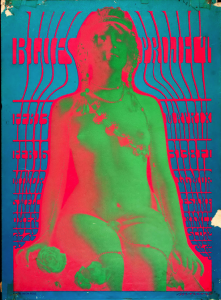
The “rock” poster was invented to advertise events both musical and social that were growing larger and larger in the San Francisco area. The seeds of the counterculture (or hippie movement) were coming of age. This movement was bound to remove itself from the ideals and rigidness of the 1950s. Creating a new culture, with its own ideals, experiences, music, fashion and sustainability.
The 60s psychedelic poster artists were very much a part of this experimentation. The three martini lunch was out! LSD and marijuana would take its place in the new counterculture. It was as much a rebellion as it was a mind expanding new frontier.
What was black-and-white in the 1950s was now bright and vibrant colors in the 1960s. The light switch had been turned on. Experimentation in all types of media would push the limits of good taste in order to be different or original. But then, bad taste could be good taste in these newfound freedoms of expression.
Whatever the case, there was much art being created around this time. Some hang in museums and some were swept away as trash. I’m speaking particularly about rock posters and handbills made usually for concerts at ballrooms and auditoriums.
The music drove the 60s psychedelic poster artists to aspire to what they did. Mostly commissioned to do concerts rock concerts, but, many would create the posters and put the shows on themselves. A good example of that would be the Pinnacle Rock Concerts that were put on in LA. (See Pinnacle Concerts posts on this site)
Although we concentrate mainly on the art, artists and famous rock posters of the 1960s–many great changes in our country were made because of the ideals and grasp for a better world from the counterculture.
Links of Interest:
Where Did Underground Cartoonist Spain Rodriguez Get His Start?
Dateline: Wedesnday November 28, 2012
Regrettably, another one of the great innovators and truly original icons of the 60s has died. Underground cartoonist Spain Rodriguez was instrumental and influential in the rise of underground comic’s.
When one reads of his childhood in Buffalo New York, you will find he (like so many of us) was engrossed with comic books. Reading, collecting, trading and trying to copy and draw all the superheroes and villains. 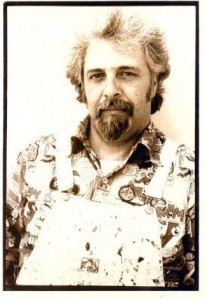
My best guess is Spain Rodriguez started his particular revolutionary comic art style when there was a censorship of comics in the late 1950s. (He was working at EC Comics for Bill Gaines at that time). I believe his anger at the establishment never left him. Illustrating tales of revolutionaries taking back the streets violently from situations of repression and corruption.
Then again, this may have started way before that. Born (Manuel Rodriguez) in Buffalo March 2, 1940, “Spain” got his name from defending his heritage in many school fights. Young Spain was a juvenile delinquent of sorts. Getting into trouble and stealing cars.
But, he had a very curious mind and was drawing comic strips from a very early age. He mentioned one time that his best art education came from working at the Western Electric Plant where he drew workers and machinery. So, we get a snapshot of the blue-collar working class background of the artist. Quoted many times and in many ways saying “I don’t know why, I just didn’t like rich people”
I believe that the most pure and best creativity comes from extreme emotions like love, hate, anger,fear and envy. As an underground cartoonist Spain Rodriguez exorcised these feelings into a new bold, bombastic and cataclysmic art form the underground comix.
After working for Bill Gaines (Mad Magazine) it didn’t hurt to have friends like underground artist Art Spiegelman and rock stars like Jerry Garcia to help his career. He would be included in the innovator’s and wave of artists like R. Crumb, S.Clay Wilson and Bill Griffith who established the irreverent, profane, highly sexed, antiwar, anti-capitalists spirit. Things very dear to underground cartoonist Spain Rodriguez. We salute you and miss you, sir.
Relevant links:
How San Francisco Band Blue Cheer makes it in Los Angeles
I am extending my conversation about San Francisco band Blue Cheer. It seems they were very much the residents at the corner of Haight-Ashbury in San Francisco. (This was at the height of Hippiedom in the mid 1960’s). It is very interesting to me how the Pinnacle Rock Concerts (based in LA) seemed to really bolster their career. San Francisco was a very fertile ground for up and coming musical artists. Many like The Grateful Dead, Jefferson Airplane, Big Brother and the Holding Company made their bones right there in San Francisco.
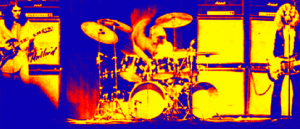 The counterculture movement was happening everywhere. It was happening in San Francisco as well as Los Angeles, New York and all the world. However (California in particular), the scene in Los Angeles (music as well) was much different than Frisco. It is interesting to me to explore why San Francisco band Blue Cheer would be so wildly popular in LA.
The counterculture movement was happening everywhere. It was happening in San Francisco as well as Los Angeles, New York and all the world. However (California in particular), the scene in Los Angeles (music as well) was much different than Frisco. It is interesting to me to explore why San Francisco band Blue Cheer would be so wildly popular in LA.
In my opinion it could be that many bands in San Francisco derived mainly from folk music roots. I know this to be true of groups like the Mamas and the Papas, Jefferson Airplane, Crosby stills and Nash and Quicksilver Messenger Service. Many of these mentioned were influenced by Fred Neil and the coffeehouses and the “beat” movement in Greenwich Village New York in the late 1950’s.
They were followers of the folk movement and turned it electric after many of them moved to California. Case in point: David Crosby wanted to call his group (before CSN) “The Sons Of Neil”. Thats how deep seeded the “folk” connection was. More on this in another post.
Los Angeles artists included The Doors, The Seeds, Frank Zappa & The Mothers of Invention, Capt. Beefheart and Love. Not really the “trippy” kind of music coming out of S.F. Although some of LA bands could be considered crossover folk acts they didn’t rely on those roots. It seems (to this author) it was much more electric blues oriented than folk music. For a San Francisco band Blue Cheer made a huge splash in Los Angeles. This music being created in LA was much more more electric, harder edged, and heavier.
As we mentioned in the previous post, Blue Cheer was wildly popular and accepted in Los Angeles. I am trying to determine if this is how they captured national attention. It is odd to me they landed a spot on Dick Clarks-American Bandstand…pretty commercial stuff.
But, you must remember their 1st Album was a huge success, peaked at number 11 on Billboard and still sells to this day. They certainly had strong management (see Eric Albronda comments), promotion and support in LA. I think I lean toward the opinion of our friends at Rock Prosopography 101
Blue Cheer had cachet insofar as they came from San Francisco, but their music was pretty far from the sinuous folk rock improvisations typical of the Fillmore. The San Francisco band Blue Cheer was a loud, loud, loud and proud power trio, playing through veritable wall of Marshall Stax amps.
I may be getting closer to some fire on this. I just stumbled across a list of gigs for Blue Cheer in chronological order (a real labor of love by Bruno Ceriotti). This is unbelievable! What I learned was the many transformations (every few months!) of this group. Five incarnations from 1966 until July 16, 1967 which evolved the power trio Dickie Peterson, Leigh Stephens and Paul Whaley. They would play non stop until September 1968 promoting the albums “Vincebus Eruptum” & “Outside Inside”. Line up #6 would soon take over.
After this research, its not hard to imagine how San Francisco band Blue Cheer made it in LosAngeles. Maybe a fish out of water. A little more extreme…a little more experimental…a little more Blue Cheer!
Links of Interest: